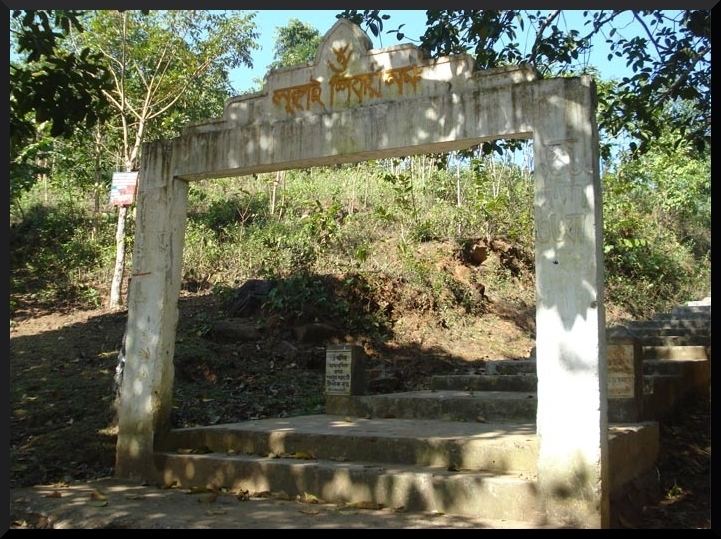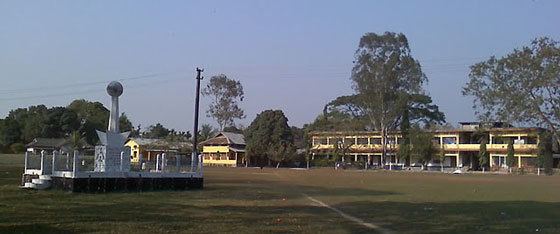Country India State | Language spoken District | |
 | ||
Map of Abhayapuri
Abhayapuri (IPA: ˌəbɑːjəˈpʊərɪ or ˌəbeɪjəˈpʊərɪ) is a small town in Bongaigaon district and 21 km away from Bongaigaon City. Surrounded by natural forests and hills, it is located on the National Highway 31, about 200 km west of Guwahati. Nearest airport is at Guwahati. Abhayapuri Railway Station is managed by the North East Frontier Railways.
Contents
- Map of Abhayapuri
- Abhayapuri best indian city to live
- History
- People and Culture
- Demographics
- Educational Institutes
- Politics
- Kakoijana reserved forest
- Koya Kujia Eco Park
- References

Abhayapuri best indian city to live
History

Abhayapuri was the capital of the ancient Bijni Kingdom established by the king, Raja Bijit Narayan alias Chandra Narayan in 1671. Bijit Narayan was the son of Parikshit Narayan who was the grandson of Yuvaraj Sukladhwaj alias Chilarai, a famed Koch general and the younger brother of Moharaj Nara Narayan, the great emperor of Kamata Kingdom in the 16th century.

The first capital of Bijni Kingdom was at modern Bijni town (1671–1864) but later the capital was shifted to Dumuria (now known as Dalan Bhanga) due to attack by Jhawlia Mech and (a local chief under Bhutan Kingdom). A dreaded earthquake occurred at 5 PM on 12 June 1897 (1897 Assam earthquake) badly damaging the royal palaces of Dumuriya, and therefore, it was decided to shift the capital again to Deohati forest area which was later named as Abhayapuri after Devi Abhoyamata, the family deity of the ruling dynasty. Later, during the rule of the last king, Raja Bhairabendra Narayan, the Government of India took over this kingdom.
The Bijni Kingdom was situated between 250 53' and 260 32' N. and 900 85' and 910 85' E. The estate was in possession of the Bijni family, descended from the Koch king Nara Narayan, who reigned over Kamata kingdom from 1534 to 1584. Before his death, Nara Narayana allowed his kingdom to be divided between his son Lakshmi Narayan and his nephew Raghu Rai (son of Chilarai). Raghu Rai established his capital at Barnagar in the Barpeta (now a district in Assam), and received as his share the Koch territories lying to the east of Sankosh River.
After the death of Nara Narayan in 1584, Raghu Rai declared independence. The eastern kingdom ruled by Raghu Rai came to be called Koch Hajo and the western Koch Bihar. Soon after the declaration of independence, the two kingdoms started showing hostilities against each other. Raghu Rai was succeeded by his son Parikshit Narayan and was defeated in 1602 by the army of Nawab of Dhaka (governor for the Mughals) who was moved by Lakshmi Narayan (ruler of Koch Bihar). Parikshit was defeated at Dhubri (now a district in Assam) and sued for peace. But soon, he continued with the hostilities and in 1614 was driven up to Pandu, now in Guwahati. There, Parikshit surrendered and agreed to become a vassal of the Mughal Empire. But before he could take up this assignment he died. The Mughals then appointed Kabisekhar as the kanungo and instructed Sheikh Ibrahim Karori to set up a Mughal system of administration. Parikshit' son Bijit Narayan, was confirmed by the Mughals as 'jamindar' of the area between the river Manas and the Sankosh, and from him the Bijni family descended. The name "Bijni", now a sub-division of Chirang district of Bodoland Territorial Area in Assam, comes from the name of the king Bijit Narayan.
Under the Mughal rule, the Bijni king Bijit Narayan paid a tribute of Rs. 5,998 which was afterward commuted to an annual delivery of 68 elephants. During the last two decades of the 17th century, the Mughals lost their influence on Assam while the East India Company gradually started strengthening their foothold in different parts of India including Bengal.
The East India Company was awarded the 'diwani' or overlordship of Bengal by the empire following the Battle of Buxar in 1764 and the company came to an agreement (known as Permanent Settlement) with Bengali landlords in 1793 to fix revenues to be raised from land. With the Treaty of Yandaboo in 1826, the East India Company finally took control of the both Esstern Assam and Western Assam. However, it was doubtful whether Goalpara was ever included in the Permanent Settlement. According to The Imperial Gazetteer of India (Volume 8), a small assessment from the Bijni kingdom was always accepted in lieu of land revenue, though it has sometimes been argued it was nothing more than a tribute. The Imperial Gazetteer of India, which was published in 1902, states that the Bijni family paid a revenue of Rs. 1,500 and cesses amounting to nearly Rs. 19,000 for an estate which covered an area of 950 square miles (2,500 km2) with an estimated rent-roll of Rs. 2 lakh.
On the conclusion of the Bhutan war (or Duar War) fought between British India and Bhutan in 1864–1865, the Bijni family put forward claims to hold a large tract of land in the Eastern Duir which they alleged that they were in possession under the Bhutan government. The claim was admitted and in 1870 a settlement was effected with the Court of Wards on behalf of the minor Bijni Raja. The present extent of the estate to which they were entitled was still matter of uncertainty, but in 1882 it was ruled by the government of India that the Raja should receive 130,000 acres (530 km2) of land. These estates generally remained under the direct management of the government, who allowed to the Raja 7.5 percent of the collections as his share of profits.
Ram Rajar Garh near Deohati village is a man-made historical pond which was excavated by Ramsingh I of Ambar Kingdom of Rajasthan. Ram Singh had the pond excavated during the Mughal campaign (Battle of Saraighat) against the Ahom kingdom.
The Lalmati-Duramari Ganesh Temple near Abhayapuri, is one of the oldest temples in Assam. The historical authenticity of the images are yet to be ascertained. Based on the study of the stone carvings and modes related to the carved idols, some archaeologists has opined that the temple and images belong to 8th to 10th centuries AD. The existence of ruins in Lalmati-Durgamari area along with temples was brought to the notice of the Historical & Antiquarian Department of the Govt. of Assam in 1974. The department undertook excavation work which resulted the discovery of the temples, images and idols of Gods and Goddesses.
The Lungai Pahar Shiva Temple is located 10 km away from the main town of Abhayapuri. Visitors need to climb the 227 stairs to reach the temple inside which there are stone carvings of Lord Shiva, Lord Ganesha and Goddess Kali.
People and Culture
Since time immemorial, Koch-Rajbonshies (belong to Indo-Mongoloid ethnic group of people) have been the living in this area now known as Abhayapuri. These people are the original sons of the soil and their existence can be traced back to the "Kiratees" of pre-vedic epic age (Mahabharata). These Kiratas of dim past are also mentioned in Kalika-Purana and Yogini Tantra and also in histories written both by native and foreign scholars.
Yogis,Kalitas, Kayasthas and older Muslims are also indigenous who settled in this part of land prior to the advent of Britishers in North East Region. Some of them settled in the area centuries before the advent of Britishers. In a much later period, people from different parts of Assam migrated to Abhayapuri.
Among major festivals, Diwali, Holi, Durga Puja, Swaraswati Puja, Lakshmi Puja, Kalipuja, Shivaratri are celebrated by the Hindus of Ahbayapuri. Those of Islamic faith celebrate Idd and Muharram. Besides the religious festivals, Bihu, the agricultural festival of Assam is celebrated by all Assamese, irrespective of caste, creed or religion.
The people of Abhayapuri have long been known for their interest in culture and education. The 44th conference of The Asam Sahitya Sabha was held in Abhayapuri in 1977 under the presidency of Syed Abdul Malik, a big name in the history of modern Assamese literature. The area where the conference was held is still known as Sahitya Sabha Path (Road).
Demographics
As of 2001 India census, Abhayapuri had a population of 14,671. Males constitute 52% of the population and females 48%. Abhayapuri has an average literacy rate of 79%, higher than the national average of 59.5%; with 55% of the males and 45% of females literate. 10% of the population is under 6 years of age.According to Census 2011, the town has a population of 15,847 (Area: 4.74 km² – Density: 3,343.2 inh./km²) that shows an increase of 0.77%.
In the last few years, population of Abhayapuri has increased surprisingly with a large number migrating government workers starting to reside permanently in the town. In addition, people migrating from nearby villages also catapulted the population. This burst in population, combined with lack of development in public infrastructural facilities, has started playing spoilsport on the once-remarkably-peaceful small town in recent years. Also, the increasing number of private and public vehicles, especially small passenger carriers like 'tempos' and vans, and motorcycles has raised serious concern about road traffic safety.
Educational Institutes
Politics
Abhayapuri consists of two assembly constituencies: Abhayapuri North and Abhayapuri South, both of which are part of Barpeta (Lok Sabha constituency).
Kakoijana reserved forest
Kakoijana reserved forest is a reserved forest famous for Golden Langur.
Koya Kujia Eco Park
Koya Kujia Eco Park is a natural water-body with its banks choked with human settlements two years back, to its metamorphosis into an eco park with lots of space offering loads of fun, is no mean journey.
